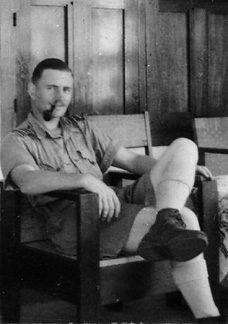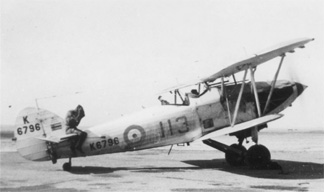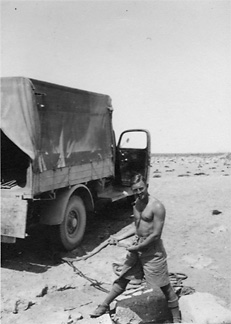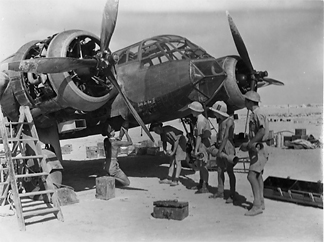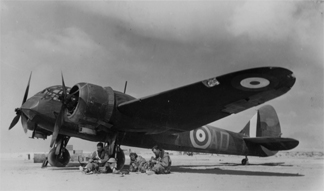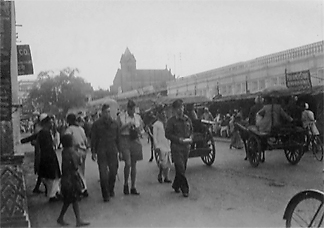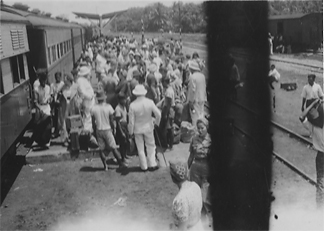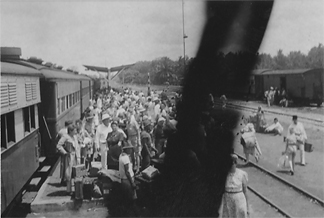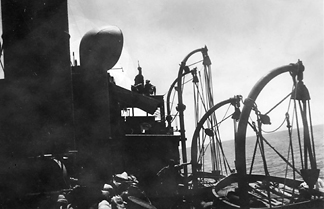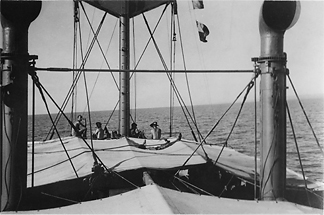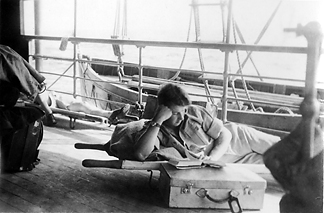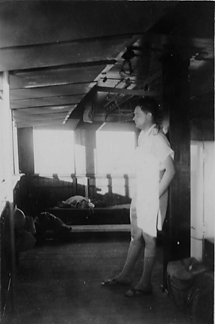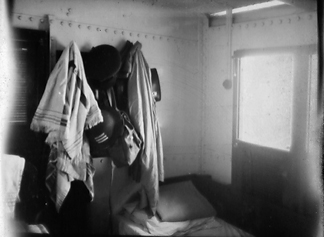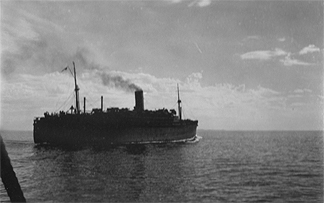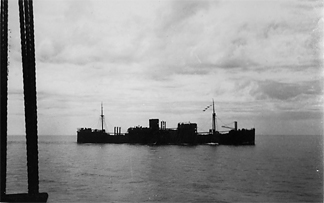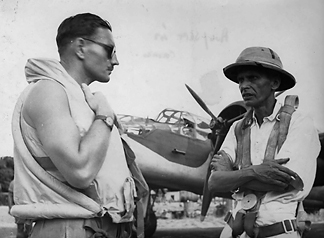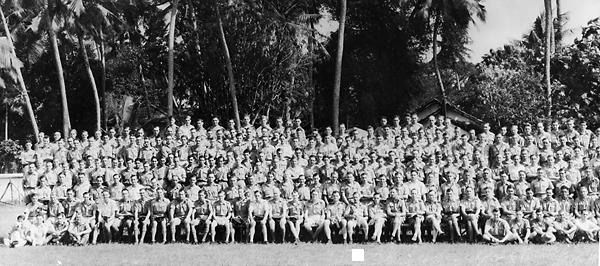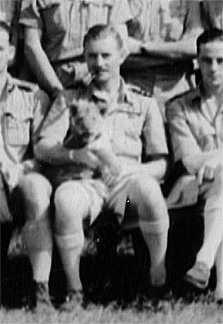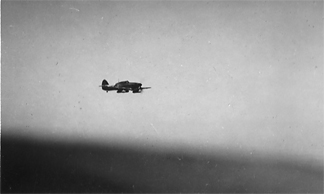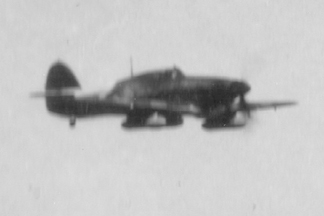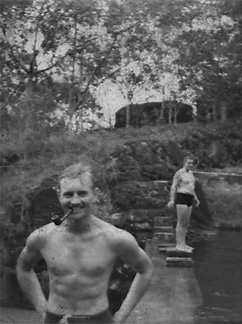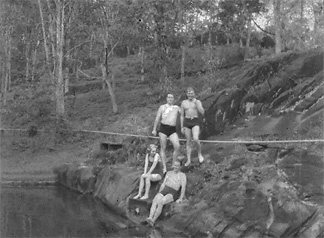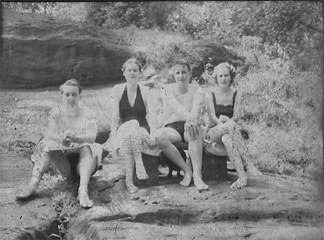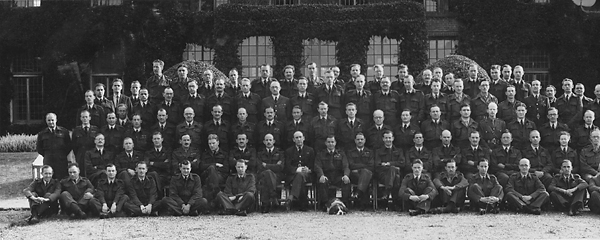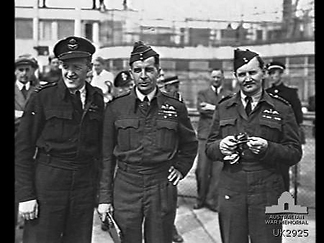 |
 |
|||||||||||||||||||||||||||||||||||||||||||||||||||||
|
Wing Commander RN Bateson 39054 DFC RAF In 1909, Edward VII had ruled Britain and the British Empire for eight years. Though nearing the end of his own reign aged 68, the Edwardian era named for him continued to flourish even as currents of change stirred in British politics and society. In late July, the Daily Mail prize of 1,000 pounds for the first powered, heavier-than-air flight across the English Channel was won by Louis Bleriot of France, landing at Dover from Calais in a monoplane of his own design. Born in the Brighton area in 1879, George Roland (or Rowland) Bateson reached his 30th year in 1909. That Edwardian Autumn, he wed Florence Maud Allen, their marriage registered in the District of Brighton, Sussex. The birth of the couple’s first son, John Allen Bateson, was registered at Portsmouth in December 1910. Their second son, Robert Norman Bateson, was born on 10 June 1912 in the Barcombe and Chailey area, not far from Lewes in Sussex, eight miles North East of Brighton. Young Robert attended school in Hove and later, at Watford Grammar School.
Characteristically photographed with pipe, faint grin, and steady gaze. Cropped from the shot with Adjutant F/Lt JW Bright in Fred Joerin’s Log Book, taken about January 1942 possibly at Helwan. To wear the blue As the RAF grew apace, balancing the complexities of training manpower, stations, courses, and suitable aircraft in quantity saw the elementary stage of Service flying training taken on by the few existing civilian schools. So in mid-July 1936, Pupil Pilot Robert Norman Bateson began his training with Brough Civil Flying School (otherwise No 4 Elementary and Reserve Flying Training School) at Brough, beside the River Humber in the East Riding of Yorkshire. At that date, Brough Aerodrome was the head office of Blackburn Aircraft Ltd, landplane and seaplane makers, who operated the School with a number of their Blackburn B-2 trainers. For its day, the B-2 was a quite advanced single-engine biplane, with its metal-clad semi-monocoque fuselage, leading-edge slats, and side-by-side seating for pupil and instructor. For ab initio trainee pilots then “...the course for the regular personnel at civil elementary schools lasted normally for eight weeks (10 in Winter) during which a minimum of 25 hours dual and 25 hours solo flying was carried out. At this stage, the pupils were civilians although paid by the Air Ministry” At Brough, with F/Lt Stockbridge as his flying instructor, Bateson flew often from 15 July, usually several times a day. Ten days later, Stockbridge was satisfied with his pupil’s progress: early on the morning of 25 July 1936, with 8:45hrs dual in the Flying Log Book, Bateson took his first solo in B-2 G-ACBJ. As Summer passed, the flying hours piled up, at first with Stockbridge still in the right-hand seat, then increasingly with “Self” as sole pilot. Robert Bateson completed his initial flying training in early September 1936, all of it flying the pretty if sedate B-2s. On 5 September, with his Log Book flying summary showing 26:35hrs dual (5:50hrs on instruments) plus 28:10hrs solo flown in just seven weeks, the Brough civilian CFI signed him out with the admirable if customarily brief assessment of proficiency: “Above Average”. For King and Country Bateson’s Short Service Commission as Acting Pilot Officer was recorded in the London Gazette of 22 September 1936, with effect from 7 September 1936. From 19 September, he was posted to No 2 Flying Training School at RAF Digby in Lincolnshire, 12 miles South of Lincoln and just three miles from the LNER station in the nearby village. Four days later, he was back in the air, this time in a rather livelier beast than the B-2s of Brough. Perhaps it was a quietly relished Digby joke when new boys drew, as their flying instructor, Sergeant Pilot Hart. However it was, Acting Pilot Officer pupil and Sergeant Instructor set off together that Summer afternoon for a short Digby local—in Hawker Hart (Trainer) K6459. Serving the RAF as a two-seat day bomber in quantity from 1930, for its day the Hart was sufficiently spirited that by 1932, older and slower AW Atlas trainers were being replaced. To better prepare trainee day-bomber pilots soon to join operational Hart and Hind Squadrons, Hart Trainers had been put into production. With armament deleted, engine de-rated, full-dual control to the instructor’s rear cockpit, and a re-jig of upper-wing sweep, large numbers of the more suitable Hart (T) were produced as expansion of the bomber force gathered pace, for service as advanced trainers in RAF FTS units (and on bomber Squadrons too, as they started re-equipping with Hinds). After seven flights amounting to 3:40hrs in a week, by 1 October 1936 his aptly named instructor had seen enough for Bateson to take his test with their ‘C’ Flight commander, F/Lt Lewis. All was well and within minutes, Bateson was off again, solo in Hart (T) K6440 with 58:45hrs in the Log Book. By the end of the month, his total flying time had reached 68:10hrs, 34:50 of it solo. In the School’s Hart Trainers and Audaxes that month, he flew for 10:05hrs, 6:40hrs of it solo. Meanwhile, older brother John, having started training around six months earlier than Robert, had been commissioned in early April 1936. In October, Acting P/O JA Bateson was among those selected for the School of Air Navigation at Manston in Kent, the latest development in the RAF’s slowly awakening awareness of the need for better navigation skills generally (and for qualified full-time navigators too). Confirmed as Pilot Officer in February 1937, at the end of March John Bateson was posted to 217 (General Reconnaissance) Squadron, an Avro Anson unit at Boscombe Down. There, long over-water anti-submarine patrols called on the navigation skills of pilots and navigators alike. Promoted to Flying Officer, JA Bateson was still with the Squadron at Tangmere in January 1939, patrolling the English Channel and beyond in their “Faithful Annies”. On entry to service in 1936, the Anson was not only the first of the expansion scheme era RAF monoplanes but also the first with retractable undercarriage—at once a novelty and a curse. It was retracted by hand-crank: “approximately 160 turns” advised the Pilot’s Notes coolly (Air Publication 1525A—PN, para 7). Later, Ansons were to train many pilots in twin-engine flying, and many more navigators and wireless operators in its comparatively spacious cabin. The last Ansons were withdrawn from RAF service as late as 1968. For Bob Bateson, November 1936 passed with more hours flying the Hart Trainers and occasional Audaxes, in more demanding flying and longer cross-country exercises, mostly solo. By the end of the month, solo flying had risen to 45:25hrs, the total to 83:45hrs . In the first month of Winter, flying time fell off a little, amounting to 6hrs in all but with the end in sight. One way and another, for Britain it was a Winter of some discontent: the uncrowned Edward VIII abdicated on 10 December. However, for Bateson a final hour on instruments with Sergeant Hart on New Year’s Day 1937 was followed with the hard-earned stamp: “Qualified for Flying Badge”, dated 2 January 1937. His Pilot’s Wings would shortly be issued and sewn on the tunic. Moving to ‘B’ Flight of the Advanced Training Squadron at 2 FTS with nearly 92hrs in the Log Book, there came a break of four weeks with no flying at all: whether it was leave or a hard winter in Lincolnshire, a break just long enough to give a new pilot pause for thought. On 3 February he was back in the air, first taking a short local solo in the morning, and after lunch an equally brief formation stint, again solo (and both in Audaxes). Enough to feel current again, but it was another six days before more serious flying came his way: an 85 minute cross-country, solo in Audax K7351. All well, the rate of flying and level of responsibility now increased, either taking turns as Pilot and Observer with other Acting Pilot Officers on navigation exercises, or on reconnaissance and instrument flying with senior pilots. The late Winter of 1936/1937 was in fact quite hard. February 1937 was notably wet across much of England, turning late in the month to very heavy and wide-spread snow falls in the North later extending Southwards. It was late March before the weather began to improve. That might perhaps explain another longish break in flying for Bob Bateson from 22 Feb to 23 March. Still, by the end of that month in ‘B’ Flight, his total flying time had passed the 100hrs mark. Come early Spring, and the pace picked up markedly. Occasionally with F/Lt Sloan at the stick, but more often “self”, and often enough with A/P/O Dugdale as Observer, he flew almost daily, and sometimes two or three exercises a day. Near the end of the month, advanced flying reached the serious stage: taking turns with Dugdale, they spent two long mornings flying Audaxes up to 10,000ft and off to the range. “Bombing”, recorded the Remarks column, phlegmatically. By April’s end, the Log Book showed 124:20hrs in the air, 70:45 of it solo, 43:25hrs of that in the Audaxes and Harts of 2 FTS. During the first two weeks of May the flying was a touch less busy, but again he and Dugdale took turn-about to go a-bombing. From 11 May, there was a two-week break from flying. In London on 12 May, His Majesty King George VI was crowned at Westminster Abbey. Then, on the 21st of the month, with 130:50hrs flying logged, Bateson’s time at Digby was done. The CO, S/Ldr HE Power, signed him out with the hard-earned RAF assessment of proficiency as a pilot: “Average”. He had flown the Audaxes and Hinds solo for 48:05hrs, gone bombing on the range as Pilot or Observer four times, and recorded satisfactory results in ground gunnery, air firing, camera gun and bombing. By the standards of those far-off days, A/P/O RN Bateson was ready to serve his newly-crowned King and his country on an operational Squadron. “Officer to report on joining...” Four days later, he was in the air with CO S/Ldr DH Carey, to make acquaintance with the Hind in a short late afternoon local: with all well, an hour alone followed immediately in the same aircraft, K5522. Taken on 103 Squadron charge with their re-forming at Andover in August 1936, in later service K5522 survived a rich assortment of adventures until July 1941 at 1 FTS, when the engine cut on approach, ending in a stall and crash at Netheravon. By coincidence, another ex-103 Squadron Hind, K5520, later made it’s way to 211 Squadron when they deployed to the Middle East in 1938. In the way of the Service, Bateson was now about to have his first encounter with the mysteries of RAF manning and posting. On 2 June, less than two weeks after arriving at Usworth, Bateson left 103 Squadron, posted to 113 Squadron at Upper Heyford, 250 miles to the South in Oxfordshire. No 113 (Bomber) Squadron had only re-formed as a Hind bomber unit on 18 May—just three days before his arrival at Usworth. With RAF expansion accelerating, the early stages of such re-establishments could be pretty testing, as 211 Squadron would also find in the first weeks of June. In Bateson’s case, looking at the dates and the Squadron numbers, it’s possible the reason for his move was quite prosaic: perhaps a simple typing mistake in the order or its signal had sent him North to join well-established 103 Squadron, when all along the intent was to send him to 113 Squadron as it stood up. In any event, on 4 June he reported for duty with 113 Squadron. 113 Squadron Before lunch on 8 June, it was time to have a look around the new patch, with a 30 minute local alone in Hind K6806: a new machine, of the third production batch, it had been on Squadron charge less than three weeks. After lunch on 10 June, a little variety came Bateson’s way. Upper Heyford was also home to the equally newly established 233 Squadron, equipped with nice new Avro Ansons. That afternoon, with P/O Downton at the stick, they set off to Manston via Henlow in Anson K8777, to collect parachutes.
Three Hinds of the Squadron en echelon, somewhere over the UK, at some date between May 1937 and March 1938. The further aircraft is K6806, which Bateson flew quite often from June 1937 through to February 1938. It’s presence helps date the image, as it passed from 113 Squadron charge in April 1938, before they left for the Middle East. The nearer machine, K6802, was flown by Bateson occasionally in the UK and the Middle East. Flown by the then CO S/Ldr Cator on 23 December 1938, it stalled on landing at Heliopolis, collapsing the undercarriage and nosing over, damaging the propeller. Thereafter, the tempo on 113 Squadron was brisk as they worked up under Batholomew’s command. Bateson now flew most days in the Hinds, and often for two, three or four times a day, on local reccos, formation practice and cross-countries aplenty, with Aircraftmen and Sergeant aircrew of the Squadron in the back seat. Formation Leader, Press Photography (Formation), Observer Test, and Instruction on New Type: now Acting Pilot Officer Bateson was showing more junior aircrew the ropes. Heady stuff, less than a year into his RAF service. In June 1937, he flew for 22:40hrs, bringing solo time to 99hrs of his 157:00hrs total—and completing his his first Flying Log Book. Through July, the workload stayed pretty brisk with 25 flights, often morning and afternoon, usually now with AC Lee in the rear cockpit. Most flights were formation practice of one sort or another, often as cross-country exercises, and quite often as formation leader. On 19 July, he and Lee had what looks to have been an exhilarating day, starting late in the morning with two terminal velocity dives from 11,000ft, the first reaching 312mph indicated. After lunch, up again, leading a cross-country formation over to Manston. There, quite late in the day, they were up once more to carry out the set-piece: Raid No 1. Quite a day. The next day, they returned to Upper Heyford via Hornchurch. The month ended with 118:10hrs as pilot in the Log. The late Summer was markedy less busy, as the Squadron prepared to move North to Grantham in Lincolnshire at the end of August. Including visits to their new Station, Bateson’s flying for August was just 5:20hrs. Meanwhile, at Mildenhall, 211 Squadron were also preparing to move. The two Squadrons were to be based at Grantham until they both left for the Middle East in the Spring of 1938. At Grantham, 113 Squadron was soon back in the swing of things, the flying tempo brisker still throughout August and September. Usually with Lee in the Gunner’s cockpit, Bateson carried on with the round of formation and navigation exercises, with radio or gunnery exercises for variety, plus occasional weather tests. Early September brought gazettal confirming him as a Pilot Officer, with effect from 13 July. By mid October, they were practising flare-path landings: it was some time since he had done any instrument flying. By the end of October, another 64 flights were entered in the Log. In November, the late Autumn weather was less encouraging and the workload eased, with just 17 flights. The shorter days brought another change: two night flying exercises. In the manner of the time, on a day bomber Squadron, it was quite some time since he had even flown on instruments. With the year drawing to a wintry close, flying activity fell off: just 10 flights for December. Still, the weather must have been reasonable enough on 14 December, as that day he took to the air in single-seater Gloster Gauntlet K7859 for 50 minutes of local flying, aerobatics and in formation to Digby, where the task next day was a Hind operational exercise: a bombing raid. As 1937 ended, P/O Bateson had been busy for six months on an operational Squadron, with plenty of flying, whether formation leading, training, or a variety of navigation and bombing exercises. The grand totals in the Log Book now showed 235:50hrs flying, 189:50hrs as pilot (with 12:30hrs on instruments and 3:20hrs at night). At the end of December, it was time for a new CO. Bartholomew left them, slated for the RAF Staff College and an Air Staff job. Post-war, at the end of his time as Air Attaché to Turkey, Air Cdr Gilbert Bartholomew was among the senior RAF officers who died in a civil flying accident at Ankara in August 1949). In the New Year, S/Ldr FG Cator 16072 took command. He was to lead them for over a year, from Home service to Egypt. An RAF Cranwell cadet commissioned in 1922, Cator had prior experience of the Middle East from a 1930 posting. Twice mentioned in despatches and a Group Captain, he survived the war to retire in 1951 with the award of a CBE to his credit. The Squadron will proceed... Unremarked in his Log Book, from early January until the end of March P/O RN Bateson was ‘B’ Flight commander. February was just as busy, 19 flights amounting to 17:50hrs—seven of them bombing exercises of one sort or another, with a couple of instrument flying sessions to boot. In mid-March, the Squadron was informed that it was to proceed overseas. Up to the middle of the month, Hind flying continued at a steady rate as in February but with more marked offensive intent, plus some more night and instrument time. After this time, AC Lee appeared no more as Gunner on Bateson’s flights. Preparations for the overseas move then took precedence, with aircraft being ferried to RAF Sealand for dismantling and crating. Bateson’s own flying for March ended in the third week of the month with a two day return trip to Sealand via Ternhill in Magister L5950, apparently to collect his occasional flying crewmate P/O Willis who came back with him in the rear cockpit. The Log Book now showed 282 flying hours, 236:00 hrs of that solo, with 19:05hrs on instruments or at night. The Squadron strength was now made up from two to three Flights, 18 Hinds in all, but on a non-mobile basis. Among those posted in at the beginning of April was one F/O Gordon-Finlayson. For his final flight in the UK for five years, Bob Bateson now managed to arrange some useful experience off-Squadron, with a special bonus. On 4 April 1938, he undertook a night cross-country and bombing exercise for 2:30hrs as 2nd pilot or passenger in an Avro Anson—piloted by his brother John of 217 Squadron at Tangmere. After returning from four weeks embarkation leave, all hands were ready for the move on 30 April . On that day, the men of 113 Squadron left Grantham by train and embarked for the Middle East at Southampton, aboard the long-serving HMT Lancashire. Travelling with them were the men of 80 Squadron and 211 Squadron, their crated aircraft transported aboard a cargo vessel for the Packing Depot, Aboukir. City of the Sun The 216 CO S/Ldr WN Blain offered the newcomers one sort of practical welcome as they awaited re-erection of their aircraft. On 12 May, he took Bateson and nine others aloft in Valentia KR2792 (a rebuilt Victoria V) for a 50 minute tour around Helio and environs. From the aerodrome on the North East outskirts of Cairo, the Pyramids at Giza were about 15 miles away across the City and the Nile, in easy reach for the doughty transport, droning about at 120mph. While 113 Squadron continued to sort out its equipment and aircraft, on 20 May Bateson was able to get some air time after a break of well over six weeks. Thanks this time to 208 Squadron, he took a 30 minute flight around the local area in Audax K3115. Later serving with 4 FTS, at the siege of Habbaniya in 1941 the aircraft is said to have been laid out as one of the “Hurricane” decoys. At the start of June it was time for P/O Bateson’s annual assessment. His Service flying stood at a tick under 300hrs in total, 160:10hrs of that flown as pilot in the 12 months since June 1937. While gunnery, bombing and navigation all drew the usual conservative “Average” rating, in a nice compliment, Cator judged his ability as a light bomber pilot as “Above average”. In the hard-marking RAF that was certainly recognition. By 8 June, some of their own aircraft were ready and Bateson took Hind K5556 up alone for a quick circuit to shake off the cobwebs. The following day, the Squadron stood down for the King’s Birthday holiday. On 10 June he took K5556 alone, again, for a longer “local”. Thereafter, the Squadron resumed a busy flying schedule. In June, 21 flights for Bateson, 18 of them in Hinds on formation and bombing exercises, and for variety, a day long stooge of 5:30hrs out to Ramallah and Port Said and back, getting the lie of the land as passenger with P/O Tomlinson of 216 Squadron at the controls of Vickers Valentia K3604 ’W’. Throughout July, August and September 1938 the Squadron kept the tempo high, while European tension was driven ever higher by the German Chancellor. Between the bombing, formation and navigation exercises, aerial photography and night flying were undertaken more often, and twice there were flights out to Mersa Matruh, 260 miles West on the Desert coast, 2 hours or more away in a Hind. In the three months from July, Bateson undertook 85 flights in the Squadron Hinds, all but three as pilot, to reach 330:50hrs flying as pilot, 16:20hrs of that at night. From 3 August, he was Acting Flying Officer, moving from ‘B’ Flight. While crewing was yet to become permanent, from then on Cpl Durrant often took the rear seat as Gunner cum Wireless Op. At the end of the month Bateson had the pleasure of signing off his own Log Book as “RN Bateson P/O, OC ‘A’ Flight”. Towards the end of September, a new duty came his way, reflecting the change in status: “Flight Commanders Test (New Pilot)”, undertaken several times for new A/P/O arrivals.
Here the aircraft is running up, the airman acting as ballast covering up against the sandy blast of the Kestrel’s slipstream. The Squadron Leader’s insignia is emblazoned on the fin. No date, but from the dress and airfield hard-standing, plainly a Middle East setting, sometime after May 1938 and very likely Heliopolis. Bateson flew this aircraft on numerous occasions from August 1938 until April 1939. To the Desert At that time, the RAF was expecting that “Italy would be the principal enemy in the Middle East”—an assessment that proved correct once war did break out, remaining so until February 1941. The need for the RAF to take such forward positions against any Italian advance had been realised back in 1936: the Libyan border was 300 miles West of Alexandria. For Hinds in 1938, the best use of their range and limited war-load against any Italian advance would be from bases closer to the action. Mersa Matruh, with its rail access back to the Delta, was less than 150 miles from the Libyan fontier. Meanwhile, in Palestine, 211 Squadron was about to be withdrawn to Helwan and prepare for a move to El Daba as part of the provision for possible war. Both Squadrons learnt a deal about mobility in Desert conditions in a fortnight of flurry. By 11 October, 113 Squadron was back at Heliopolis, where they practiced hard for the great mass fly-past of 18 October: 140 RAF aircraft in formation over Cairo in a show of strength to bolster Anglo-Egyptian relations. Bateson, in Hind K5420 with LAC Angell, flew as Leader, No 2 Flight of the Squadron’s 12 aircraft contribution. Not suprisingly, although the crisis passed, the state of readiness of the Squadron remained high, flying activity indeed increasing by December. By then, the emphasis on bombing exercises (high and low level, and dive bombing) was clear, together with more night flying. Formation practice, cross-countries and fighter affiliation all played a part, too, the routine broken only to search for a Blenheim missing over the Sinai from 11 to 14 December, 211 Squadron also taking part. The aircraft was not found. By the end of 1938, after 18 months service with 113 Squadron, F/O Bateson had advanced in rank, to command of a Flight, with his Flying Log Book standing at a grand total of 463:30hrs service flying, 417:30hrs as pilot (26:55hrs at night). Change in the air By 7 February, Cpl Durrant had advanced to Sergeant and was manning the rear seat for Bateson on most flights. Over the course of February, they kept the pace up, flying the varied programme of exercises every day, often several times a day, with plenty of visits to the Western Desert bases, or East to Ismailia and the Suez Canal. At the end of the February 1939, Cator left them, S/Ldr Gerald B Keily 27256 from 216 Squadron taking over command. An experienced Flight Commander, he had also served with 45 Squadron, after several years instructing with 4 FTS at Abu Sueir near Ismailia and the Suez Canal. In March, the programme eased a little, perhaps as result of aircraft maintenance in preparation for a move: Bateson recorded a number of flights as “Engine test after fitting new cylinder blocks”. There was also an amount of survey flight training to and from Mersa Matruh, followed late in the month by reconnaissance of the Desert for more landing ground sites. On 23 March came his Gazettal to Flying Officer, with effect from 13 February. Over the first three months of 1939, Bateson’s flying duties added well over 80 hours to the Log Book, which at the end of March showed a grand total of 550:05 hours service flying, 504:05hrs as pilot, 37:00hrs of that at night. Flying was a little busier in April but rather different in character, with some restrictions ordered by HQ Middle East. No more practice bombing, quite a lot of assorted air tests, some recco work over the Desert coast, and so on. On 7 April, Italian troops invaded Albania, reflecting the long-standing ambitions of Benito Mussolini. In view of the increased tension, on 21 April 113 Squadron moved forward from Heliopolis, “up the Blue” to El Daba for a month. They found 211 Squadron had arrived the day before. At the end of the month, Bateson was able to sign off his Log as F/Lt. The Blenheims arrive Blenheim Delivery Flights from the UK continued throughout 1939 and 1940. In retirement, Bob Bateson recalled "...it was probably in 1939 that they started ferrying Blenheims out from the UK and there's quite an interesting little story associated with that because, when the first Blenheims arrived, they landed at Maaten Bagush which was the airfield I was on at the time. Of course we clustered around straight away to see these new aircraft - absolutely marvellous - monoplanes - twin engines - you name it they'd got it. [They] even had radios in it and navigation equipment and so on. The chap got out of the first aircraft and I met him and made him welcome [and] asked what he wanted - they wanted petrol and some food. He said, "Your name's Bateson." And I said, "How on earth do you know that?" And he said, "We went through the conversion course at Tangmere and the chap running the course said, "If you're met by somebody smoking a pipe it'll be my brother." My brother was running the conversion unit at Tangmere in this country [UK] and sending them out to the Middle East..." [Difficult to date and place this nice yarn exactly, beyond early 1939. The context is pretty clearly before 113 Squadron’s own re-equipment. They had spent some weeks at El Daba and from there or from Helio had often visited Mersa Matruh—from where the Landing Ground at Ma’aten Bagush is only some 25 miles back East along the coast. However, neither Bateson’s Log Book nor the Squadron diary Form 540 (rather sparse for the first six months of 1939) mention any early 1939 activity at Maaten Bagush itself. When the war did finally reach the Middle East on 10 June 1940, it was to be their War Station. Still, there was plenty of flying activity along that 80 mile stretch of Western Desert coast in early 1939. A true story, vividly recalled, of a brother by then long dead: worth the recounting, whether it was Mersa Matruh or Maaten Bagush.] On May Day, the 211s returned to Ismailia, to await re-equipment with the twin-engine, three-seat Bristol Blenheim I in place of their Hinds. Despite the political situation, when an Italian aircraft went missing in early May, 113 Squadron lent a hand, Bateson taking off at first light on the 4th for a long search out to Sollum and Sidi Omar, and again in the afternoon with Sgt Durrant, tracking up the border to Sollum, to return on dusk to Mersa Matruh. That month, there was quite a lot of reconnaissance activity, along with the local flying and air tests. On 21 May, 113 Squadron returned to Heliopolis, it being their turn to convert from Hawker Hind to Blenheim I. The time for Bateson’s annual assessment had come again. Over the 12 months since June 1938, he had flown 329:45hrs, 33:00hrs of that at night, of his grand total as pilot of 566:15hrs. If his CO felt some satisfaction in completing the usual Form 414, it must have been at least matched by Bateson’s own reaction. In all four classes (as Light Bomber pilot, as pilot/navigator, in bombing and in air gunnery) the slip pasted into his Log Book bore the same assessment: “Above average”. Heady stuff, in the hard-marking RAF. On the same day, 1 June, S/Ldr Keily flew the Squadron’s first Blenheim to Helio, from the Depot at Aboukir. His long period of instructing at 4 FTS was also recognised at this time, with award of the Air Force Cross. On 14 and 15 June it was Keily himself who took Bateson up in the dual-equipped Blenheim I L1499, first to observe the CO instructing Sgt Bagguley, then at first light the next day as the pilot under instruction, with P/O Williams along to watch. Shortly after landing, Bateson was off again solo, for an absorbing 35 minutes of circuits and landings in L4824. Meticulous and not quite satisfied, perhaps? Certainly later that morning he was up again, in L1542, for a further set of circuits and bumps. If getting obsolescent for Home Squadron use in the last Summer of peace, for those days in the Middle East, the Mark I Blenheim was quite modern, quite fast and quite powerful. Mishandled, the aircraft could certainly bite, especially if the two Mercuries were subjected to hamfisted treatment on take-off—or attempting a hasty go-round. So at first light on 16 May, he was up again, by now confident enough in L1542 to spend time getting the feel of single-engine flying (a potentially difficult prospect, especially on take-off or landing). The next four days literally flew by, as several times a day he took groups of personnel up in assorted Blenheims for air experience, or out to the Aircraft Depot at Aboukir (only 45 minutes away in a Mark I) to collect new aircraft, or to acceptance test the new arrivals. And to practice single-engine flying again, solo. After a short break, it was time for serious work. The Squadron’s new flying programme began in earnest, with four days of navigation, bombing exercises, and air gunnery. After that first 40 minutes dual, by the end of June 1939 F/Lt Bateson had added a tick under 12 hours as a Blenheim pilot to his Log in 14 days. The Squadron as a whole flew 225hrs over the month: a respectable total in the midst of conversion. In July the Squadron started to pick up the pace, flying 230hrs. For Bateson, flying duties were well up with 20:25hrs in the Blenheims, much of that on bombing exercises by day and night, and a fair amount of formation practice: in the bigger Blenheim, with a single-gunned turret, good formation flying was essential for effective defence. By August, 113 Squadron were confident with their new aircraft. That month the Squadron flew 293hrs. Not only did the flying pace pick up markedly: their state of readiness was such that from mid-month, at weekly intervals, they were able to spare three crews (Sgt Bagguley & co, then Sgt Marpole & co, and finally Sgt Racliffe & co on 27 August) for Home and Blenheim Delivery Flight ferry duties back to the Middle East. Like Burnett and Wright of 211 Squadron, for Marpole at least it was January 1940 before he was able to return to Egypt, his return overtaken by the outbreak of war in Europe. For Bateson, on top of the usual bombing and formation exercises, he was able to fit in a number of air and engine tests (having forced-landed L1542 in the dawn at Aboukir after the port engine failed on an operational flight on 16 August) and a number of Blenheim instructional flights for P/O Lands as well. In all, he flew 27:20hrs in Blenheim that month. His service flying then stood at 688:25hrs. Meanwhile in Europe, Germany and Russia had reached a fateful accommodation. The Molotov-Ribbentrop Pact of mutual non-aggression, signed on 23 August, boded ill for Poland. War was now certain to come—and soon. Phoney War In Egypt, 211 Squadron had already moved to their War Station at El Daba. At Heliopolis, 113 Squadron spent six days firstly at six hours, then two hours, and finally four hours notice for active service operations, during which time general mobilization of British forces in Egypt was ordered on 4 September. Still, war did not come immediately to the Middle East, Il Duce content for the moment to remain a “bellicose non-belligerent”: to strut, in other words, rather than to strike. In truth, whatever destruction his forces had been able to wreak upon the rural peoples of Libya, Abyssinia and Albania, no element of the Italian armed forces was ready to prosecute war against a well-armed modern opponent. The Poles, under swift attack by German and then by Russian forces, were overwhelmed. Surrender came after less than five weeks of blitzkrieg. The uncertain period that followed soon came to be known as the Phoney War, though for Poland nothing could have been more genuine. From the point of view of Britain, the Commonwealth, and France, at least some months still remained in which to prepare for direct hostilities. On 7 September, 113 Squadron resumed normal working hours at its permanent station, Heliopolis. Resuming live bombing practice, by the end of the month the Squadron had flown 289 hours. Bateson as ‘A’ Flight commander had contributed 22:00hrs of the total in 21 flights, evenly divided between dual instruction (with solo checks) and live bombing on the Suez Rd ranges (in various evolutions of Squadron formation). October passed at a similar pace: 295 hours flown by the Squadron. Under orders to revert to practice bombs on the ranges, the flying duties were a mix of high and low level bombing, cross-country navigation, and tactical reconnaissance exercises, plus rather more night flying. Bateson himself undertook about the same amount of flights, adding 19:55hrs to the Log Book, often with Sgt Horton as Observer and any of a number of Gunners in the turret. Through November the Squadron exercised just as hard, 311 hours flown, much of it over the bombing ranges (several times at night) and on gunnery exercises. For Bateson, flying duties were a touch lighter at 17 flights in 17:20hrs flying. For the last month of the year, the flying hours did relax a little, although exercises reached a climax mid-month. The Squadron sent nine aircraft to Fuka, from where over the two days 12 and 13 December they mounted exhilarating (if tiring) long-range Air Defence mock attacks on targets at Alexandria and Cairo, carrying full war loads. Of these, Bateson took part in the low level op against Cairo Main Station flying at 300ft (sic!), and the next day at 18,000ft on oxygen against Alexandria. As his Squadron stood down for the 1939 Christmas break, Bateson had flown 15:00hrs, 3:00hrs at night, for the month. His Service Flying now stood at 762:40hrs, 133:55hrs of it in the Blenheim Is of 113 Squadron. On 27 December, S/Ldr Keily returned to the UK for Blenheim Delivery Flight duties. “Velox et vindex” For 113 Squadron, welcome changes came in March 1940, with the return of their CO, S/Ldr Keily and leading a flight of Mark IV Blenheims no less. Then on 20 March, the AOCinC visited Heliopolis to present the Squadron with their RAF badge, the crosses and swords recalling their World War I service in Palestine: “swift to vengeance”. Flying activity was reduced in the last week of March as they carried out a practice pack-up, ready to move to a War Station if need be. In the three months to the end of March, Bateson himself was busy with Mark I training and test duties, once or twice put off by the odd sandstorm or low cloud. There was plenty of variety: line-overlap photography (for mapping); bombing exercises high and low level; navigation and cross-country flights including a visit to Habbaniyah, Amman and Lydda; formation, cloud, and night flying; gunnery; some dual instruction duties; engine and rigging tests; and on one occasion, a demonstration flight to show how to get out of strife with a cutting engine at take-off. Many of these flights were in L1542, a Mark I which later went to 211 Squadron. With another 50:45hrs on Blenheim Is, his service flying total stood at 811:50hrs. As the Squadron started receiving their Mark IV machines, the Mark Is were gradually being moved on, with BDF ferry duties to other stations. It was September before the last had gone. In April they were exercising with their own Mark IVs, and in May, taking some on BDFs down to Aden. By then it was Spring in Europe—the poppies were blooming again in Flanders. On 9 April, the Wehrmacht had invaded Norway and Denmark. The poor Danes, overwhelmed, surrendered that same morning. On 10 May, blitzkrieg spread West, with attacks against Holland, Belgium and France. In England, Churchill succeeded Chamberlain that day. The Phoney war was over. In Egypt, there was still time to exercise. For 113 Squadron, working up with the Mark IVs was the big task. On 3 April, Keily took Bateson aloft for 2 circuits in Mark IV L9218, and that more or less set the pattern. Lots of flights, often short, as the gen was passed on to aircrew of the Squadron: take-offs, landings, stall tests and the like, interspersed with several long-range flights to check the endurance of the new model, ranging as far as Jaffa and Port Sudan at 14,500lb with full war load. Bateson accumulated 20:15hrs in the Mark IVs in April. May was busier still, as the war in France grew ever grimmer. That month, of the Squadron’s total of 360 hours, F/Lt Bateson flew 34:10hrs in all, 22:45 of that in the Mark Is still on charge. There at the end of May, their Operations Record Book came to a temporary end. An undated page, handwritten, punctuates the record: “JUNE—AUGUST 1940 War comes to the desert ITALY DECLARED WAR ON FRANCE & GT BRITAIN That afternoon he took off for Maaten Bagush in Mark I L8463 with P/O Shekleton and Sgt Gilbert as crew, and LAC Thomson as passenger. “On move to Sqdn War Station” he noted. Over the next 11 days, he flew six operational sorties against the Italians in Libya. For some reason, Keily and Bateson flew a party of 17 back to Heliopolis and on to Ismailia on 26 June, in Valentia JR9765—a move unremarked in the Middle East Campaigns narrative. Through June and July, 113 Squadron was very active on raids and reconnaissance sorties over Libya, losing four aircraft on operations in June with six men killed in action and six taken prisoner by the Italians. By 3 July, Bateson was back at Maaten Bagush, mounting a long photo recco sortie, dashing back to Ismailia with the film that evening, and on to Heliopolis next morning with the prints. By the end of July, he had undertaken two more such sorties. On the second, a fuel feed problem caused him to forced land at Sidi Barrani after 5 hours in the air: “Two dead motors” he noted, laconically. No harm done and by the end of the month, he had clocked up 12 ops, including the three deep reccos, mostly with Shekleton and Thomson as Observer and WOp/AG. The Squadron took no casualties that month. Early August was comparatively relaxed, with 48 hours leave for the three at Helwan. Like 211 Squadron, war-time or not, they took L8446 (a Mark I) as their leave “bus”. On 9 August they headed back to Maaten Bagush in the early morning. By late morning, they were back in the air, off to Benghazi on a 6:20hr photo recco, flying 1,200 miles at 20,000ft. Early the next morning, off to Helio with the results: “AOCinC Very Pleased”, Bateson noted—and flew back to Maaten Bagush late that afternoon. Four flights in two days, 10:50hrs in the air. By the end of the month, the ops tally was 17 for Bateson, including four more of the long range reconnaissance flights in Mark IVs (of which the last two were of 7 hours or more duration). His last raid in a Mark I came on 31 August. There was cause for some celebration for the Squadron when on 20 August the award of a DFC to the CO, now S/Ldr Keily DFC AFC, was gazetted. The month ended with nil casualties in action. It was 13 September 1940 before Italian ground forces finally advanced into Egypt. Having taken Sidi Barrani and the local Landing Grounds, by 20 September they were already digging in. The Italian advance had run out of steam, one week and 60-odd miles into Egypt. That month, Bateson was very busy, adding 35 flights to the Log Book. While bringing the ops tally to 27, including another 6 hour recco flight out over Northern Libya and Benghazi, he was also able to fit in a number of dual instruction and supervision flights on the Mark IVs. On 12 September he made two last flights in a Squadron Mark I, taking L1542 with 4 passengers to Sidi Barrani to salvage a forced-landed Blenheim. On top of all that, there were satellite ‘dromes to check, at “Waterloo” (LG 68) and at Zimla (both lay near the road, between Bagush and Fuka). By the end of the month he had flown well over 50 hours all up, in Mark Is and Mark IVs, the service flying total standing at 1027:30hrs. The Squadron was again suffering casualties, by accident and in action, the CO among them. On 18 September, nine aircraft attacked El Tmimi against ineffective pom-pom fire and severe CR42 opposition. In Mark IV T2048, S/Ldr Keily and his crew P/O JS Cleaver (Observer) and Sgt J Jobson (WOp/AG) were shot down in flames. Keily survived and was taken PoW. His crew died. Bateson assumed temporary command of his Squadron the next day and Acting Squadron Leader rank shortly after. Keily, born in India in 1904, had joined the RAF in 1929. He was a very experienced pilot by the time he came to command the 113s in early 1939. Gazetted Wing Commander on 1 September 1940, he ended up in Stalag Luft III and survived the war. Made Group Captain in 1947, and acting Air Commodore in 1949, he was seconded to the Pakistani Air Force for a time. Substantive Air rank came in January 1952. Gerald Barnard Keily DFC AFC retired from the RAF later that year and died on 14 September 1962 in Wales. October began with a Squadron raid from Zimla on Bengahzi, the nine aircraft slathering the port area with SBC loads from 15,000ft to no opposition. Most of the action that month was from Zimla, and much of it at night with five raids all on Benghazi, all of them from inland via Siwa Oasis. By the end of October, Bateson’s ops tally stood at 34, and his flying for the month 55:45hrs, 19:20hrs of that on the five night raids. Across the Mediterranean, Mussolini’s forces entered Greece across the Northern border with Albania on 28 October. Although there was no Italian advance in the Desert, for 113 Squadron the operational tempo remained pretty brisk over the Winter months of 1940, mainly daylight raids from Zimla in November. In December,, the initiative passed from the Italians with British Commonwealth forces moving forward. By 9 December, the Italians were falling back from Sidi Barrani. There was quite a bit more night action for 113 Squadron, increasingly from Waterloo, in support of the ground offensive. As CO, Bateson was still finding time to find and test out new Landing Ground sites, but markedly less time instructing. By the end of the year, after nearly seven months of shooting war, he had completed 230 hours operational flying, in 54 raids and recco sorties, for a service flying total of 1182:30hrs. Since hostilities opened in the Desert, his Squadron had lost 10 aircraft on operations, with seven men PoW, 19 killed and one injured. One pilot died in the course of night flying. 1941 By 31 January, in almost eight months on operations, he had carried out 66 raids and reccos in 263:40hrs of operational flying, mostly in Mark IV Blenheims. Then, with the fortune of war for the moment in their favour, it was time for Bob Bateson to leave his Crusaders. The tides of conflict were to ebb and flow across the desert until well into 1943, but Bateson’s duty now lay elsewhere. The Log Book tells the story 1400 30/1 [Blenheim IV] T2182 Self, Mohammed Hassan Khalil, F/O Mann. Command of 113 Squadron now passed to W/Cdr RH Spencer. The Squadron carried on desert operations for some weeks, before being sent to Greece in March. In that doomed campaign they too were badly knocked about, all their remaining aircraft destroyed on the ground at Niamata in April. By the end of May they were back in the desert, on ops at Maaten Bagush once more. Awarded the DFC in July, by August Spencer was gone, killed in action on 31 August. There we must leave the 113s, fighting hard “up the blue”: at the end of December they were to be the first of the four Middle East Blenheim Squadrons to head East to take on the Japanese. Back in Cairo on the Air Staff at HQ RAF Middle East, Bateson got to grips with staff work. Not a man to sit back with feet up on the desk for long, Bateson found plenty of opportunity to stay current in the air, flying to and fro by Hind, Magister and Proctor in the course of duty. Often enough as pilot he took more senior brass as passenger, as they looked into aspects of twin-engine training. The Martin Maryland was starting to replace the Blenheim about then—indeed, for a time, it had been mooted that 72 OTU be Maryland equipped. On Anzac Day 1941, a change of focus came his way, with a stint at 202 Group HQ Heliopolis, apparently while looking into Ops Training. For a time at Helio, he was able to take up instructing again, a decorated Air Staff Squadron Leader showing Sergeant pilots how to encourage a Blenheim to do its best. After the early elation of recapturing Sidi Barrani and Tobruk, in February 1941 the arrival of Rommel and the Afrika Korps in Libya brought a fresh round of fighting withdrawal, back to the Egyptian border by May 1941. A dark period of the war, with defeat in Greece, the great strain of the U-boat war near its peak in the Atlantic, and the failure of Wavell’s June 1941 Battleaxe thrust in the Desert. On 7 July, the Air Staff Ops Training work took Bob Bateson back to HQ RAF Middle East. There was to be little flying for some time, apart from a rather au revoir flourish on 26 July 1941. That morning he converted F/Lt Cliff on to the Mark IV Blenheim: Cliff was then duty pilot to none other than Air Chief Marshal Sir Edward Ludlow-Hewitt KCB DSO MC, Inspector General of the RAF. Thereafter, August, September and October passed with flying “Nil”. His service flying time at that point totalled 1291:15 hours, having add barely 47 hours since February 1941. Perhaps it was in this period that he had a close encounter with an Italian booby-trap bomb. Temporarily blinded, he later recalled being flown to Cairo and classified “unfit to fly”. His vision improved with daily treatment and he resumed flying. After nine months off operations, Bateson returned to the Desert. On 26 October he was posted in the rank of Wing Commander as SASO to 270 Wing, under Grp Cpt Beamish at Fuka. Preparations were well in hand for Auchinleck’s Crusader offensive. From 18 November, Eighth Army troops and armour surged forward deep into Libya, supported by the Desert Air Force. As Senior Air Staff Officer, liaison and operational awareness were right up Bateson’s street. To be on the spot, he took once more to the air, often enough by Hart or Audax for shorter trips with one passenger, or by Blenheim with larger groups. His first flight after the long break, on 6 November, was to pilot Blenheim IV Z9609 from Fuka satellite to Heliopolis with Sgt Hughes and three passengers, returning to Fuka satellite two days later. Wing HQ had moved to Gambut on 18 December. On two occasions, with Grp Cpt Kellett aboard, Bateson was able to take part in operations again: in Blenheim IV T2249 for a raid on Bardia on 17 December; then ending the year with real dash—a mid-day sortie on New Years Eve in Hart K6424, Kellet in the back seat, flying a recco of Bardia at 2,000ft during an attack. “Having a look!” The operations count now stood at 68. By then, a new element had already entered the war equation: on 7 December Japan had attacked Pearl Harbour and Malaya. To 211 Squadron His posting orders came on 6 January 1942, to command 211 Squadron. They were already at Helwan, re-equipping and getting up to establishment, this time as a 24 aircraft Squadron, bound for the Far East to fight the Japanese: a Wing Commander’s post. On 9 January, Hugh Clutterbuck apparently flew out to Gambut in a Mark IV to collect him—certainly Bateson flew the anonymous aircraft back to Helwan, noting one F/Lt Clutterbuck as 2nd Pilot or Passenger. In his later recall of the Italian booby-trap injury to his eyesight, Bateson associated his recovery with an unofficial test flight in a 211 Squadron Blenheim at Helwan on taking command, however, his recall sits at odds with his flying record. Nil flying hours from August to October 1941 then, in the first week of January 1942, almost daily flights made before leaving 270 Wing, immediately followed by the flight to Helwan on 9 January. Five days later, he was flying again, a 40 minute aircraft test in Mark IV Z9649 with “Capt Bloomfield and crew”, presumably SAAF personnel. By the third week of January 1942, Rommel was back on the offensive. Bateson was very busy at Helwan, working hard to get his Squadron ready for the testing move to the Far East. Together they faced a journey of some 6,000 miles, whether by sea or by air, to take up operations. At this point, the next entry on the Duty page records “Posted to Command No. 211 Bomber Squadron and Move to Far East” The three corresponding entries in the Record of Service table, that most valuable reference in Flying Log Books of that period, hold much of interest.
In short, they were at Helwan until 24 January, Bateson as CO in the rank of Wing Commander. From 25 January 1942, he was to fly daily with his 211 Squadron crew en route to the Far East, reaching Palembang in Sumatra on 2 February. The four Middle East Squadrons of this 1942 movement to re-inforce the Far East all dealt with the practicalities of the long ferry route in the same way. The departures of their aircraft from Egypt were staged, so that each Unit didn’t over-stretch resources en route, nor, all things being equal, get in each other’s way. The bulk of their equipment and ground personnel and spare aircrew went by sea. To the Far East By this date, he’d made more than passing acquaintance with “his” 211s. The aircrew were a mix of old hands from the Desert and Greece plus a large contingent of RAAF men (many fresh from 70 OTU or 72 OTU, a number with a little prior Squadron experience). A great many of the ground staff were experienced men who’d been in the Middle East for some time, many of them with 211 Squadron. Bateson made his dispositions accordingly. The Sea Party was first to go, departing Helwan on 16 January for Port Tewfik to board HMT Yoma. Among this group, apparently led by F/Lt John William Bright 85322, the Adjutant, were the spare aircrew and the bulk of the airman and NCO groundcrew: 400 men or more. Bright, the bespectacled “Bright Eyes”, had been commissioned in the Admin & Special Duties Branch in August 1940 and had joined 211 Squadron in the Desert, shortly before they went to Greece. He had been promoted to Flying Officer in August 1941. On 17 January, Yoma departed Port Tewfik with the groundcrew, equipment and spare aircrew of 84 and 211 Squadrons. Bateson’s orders (and intentions as Officer Commanding) were to fly 24 aircraft over 6,000 air-miles along a known but demanding ferry route, to bring them to their destination in good order sufficient to soon mount operations with minimal support, equipment and groundcrew. Each aircraft took a groundcrew NCO passenger plus tools and kit. Within that operational requirement, Bateson’s choices for his Air echelon were characteristic. He would lead the first Flight of six himself. He had already chosen his crew, from among the old hands: as his Observer and navigator, Sgt Peter Dennis (a Squadron member since at least July 1940), and as his Wireless Op/Gunner, young Sgt William Baird (a member since September 1940). As passenger, accommodated austerely in the centre-section well, came Cpl Williams (possibly 623168 Cpl Williams R, otherwise “Dai”, a pre-war RAF airman who had been with the Squadron at Wadi Gazouza if not before). To lead the final Flight of six, he chose the able and well-regarded Canadian, Ken Dundas DFC, a 211 veteran from June 1939 who was now a Squadron Leader. They would depart four days later, on Wednesday 28 January. Dundas had acted as OC at the end in Greece and was very experienced. Apart from his six aircraft Flight, he could be relied on to gather, if possible, any stranded crews from earlier Flights whose aircraft had let them down en route. On the morning of 25 January at 0800 GMT (0900 Cairo), in Blenheim IV Z9649, Bateson took off from Helwan with Dennis, Baird and Williams, heading for Habbaniyah in Iraq. Encountering a bad sand-storm, Bateson chose to land instead at the H4 pumping station in Trans-Jordan on the Iraq oil pipeline, before going on the next day to Habbaniyah where they remained overnight. Early on 27 January, they took off for Muharraq in Bahrein. That afternoon, they pressed on down the Persian Gulf to Sharjah in the United Arab Emirates. They spent the night in the fort. Early in the morning of Wednesday 28 January, they made the flight across to Karachi in India (now Pakistan), arriving after 4:20hrs in the air. They stayed the night in a hotel on the aerodrome. Crossing India the next day, they reached Allahabad after nearly 5 hours in the air. ”Very small LG” remarked Bateson tersely, as they stopped briefly to refuel. After lunch, they were back in the air, arriving at Dum Dum LG on the outskirts of Calcutta that afternoon, having flown for 7:25hrs that day. They stayed the night in the Grand Hotel. Back at Helwan on 28 January, Dundas, senior Flight Commander and leading the last 211 Squadron Flight to depart, was taking off in Mark IV Z7643 with two other old 211 hands as his crew: 749525 F/Sgt GA (Jimmy) Riddle (Observer) and 651720 Sgt GNV (Chig) Chignall (WOp/AG). His two sections of three aircraft were: S/Ldr Dundas DFC (Flight Commander), Sgts Riddle and Chignall F/O B West, F/O Ritchie, Sgt Keeping (all RAAF) On 30 January, Bateson and his Flight took off from Dum Dum late in the morning for Toungoo on the Sittang River in Burma. “Incredible country—dense jungle” he noted once they’d arrived safely after a flight of just over 3 hours. They remained two nights in the historic city (Bateson was running a high temperature, he later recalled). In the five days since setting out from Helwan they had been flying for 26:25hrs. For the next two legs, they were potentially liable to Japanese attack, both counting as operational for tour purposes. Rangoon had been under air attack by the Japanese since late December. Leaving Toungoo early on 1 February, they reached Rangoon (that is, Mingaladon airfield) in 1:20hr. There 113 Squadron were already in residence and mounting operations. Sumatra vs Singapore Bateson later recalled that it was at Rangoon that the decision to proceed to Sumatra was made (rather than to Singapore). Although differing in internal details, accounts of 84 Squadron point to the same conclusion: having left the Middle East earlier than 211 Squadron, they were proceeding to Sumatra from the outset, there to operate in defence of Singapore. On this, ACM Brooke-Popham reporting in 1942, AVM Maltby (writing in 1947) and the post-war Air Historical Branch narrative are all in accord: 225 Group (which would be in immediate command of both Squadrons) was being set up at Palembang a week before the aircraft of 211 Squadron left the Middle East. The possible diversion of units and resources to Sumatra had been decided by late December and acted on from mid January. The narratives of a number of other RAF participants are in agreement. F/Lt Terence (Pat) O’Brien with his Flight of ex-53 Squadron Hudsons from the UK, now attached to 62 Squadron, had arrived in Singapore on 16 January. The final stages of their long journey were Rangoon to Lho’nga near Koetaradja (Kota Radja), then down the East coast of Sumatra, before turning for Singapore. His stay was short. From 22 to 29 January, the bomber units on Singapore were withdrawn to Sumatra: 27 and 34 Squadron Blenheims notionally to Pakenbaroe; the Hudsons of 1 and 8 Squadrons RAAF and of 62 Squadron RAF to Palembang P2. The chat on 211 Squadron, that they were going to Singapore, may have been seen by AHQ staffs as a desirable and practical objective in early December. It is clear, though, that by late December re-deployment to Sumatra had been decided and that by mid-January action had already been taken to transfer 225 Group command. Plainly the intention was to proceed direct to Sumatra and support Singapore from there: by then the only practical option. It was a difficult period of the war, for which surviving records are far from complete and not always in agreement with each other, while the vagaries of later recall add another layer of complexity. From Rangoon to Lho’nga (known to 211 Squadron as Lho’nor) via the Andaman and Nicobar Islands was some 900 miles by air, which Bateson recalled later as being just feasible. Thus by mid-morning Bateson & co were off again, using this leg to make a reconnaissance over the Andamans and Nicobars, before landing at Lho’nga airfield (written as Loh’nor by Bateson, modern Lhok Nga) some six miles South West of the provincial capital Koetaradja (modern Banda Aceh) with its own pre-war KNILM field, some six miles South West of the town. Arriving after a flight of 5:40hrs and short of fuel, they found the strip rather short, the ground defences trigger-happy and the reception otherwise cool, but they remained overnight. Others on this route found the strip hard to find, or suffered from map, briefing or navigation difficulties in indifferent weather, resulting in some forced landings. To Palembang and P2 Within half an hour they were on the last leg, heading inland to reach the new satellite airfield referred to as P2 (ie P II) in the jungle at Karengendah 20 minutes or 34 miles from Palembang by air, or about 42 miles by road and by ferry-crossing. The area was also served by railway from Palembang and on South East to the old Dutch port of Oosthaven, some 250 miles away on the Southern tip of Sumatra. By 15:30hrs on Monday 2 February 1942, the long journey East was done. Nine days in the air, over 6,000 miles flown, in 38:35hrs flying time. Of 211 Squadron’s initial strength of 24 Blenheims, it has now been possible to identify or provide some sort of service summary for at least 19 of the aircraft which reached Sumatra. Tuesday was spent getting things organized. Late in the morning, it was back to Palembang for a long session, returning to P2 late in the afternoon. On operations: P2 “6/2 Blenheim IV Z9649 [Sgts Dennis and Baird]. Bateson’s own WOp/AG, Bill Baird, logged this operation as 7 February, take off time 1210hrs, Reg Cuttiford in Z7622 also logged the date as 7 February (but not the take-off time). In their “forbidden” diaries, Burrage and Keeping both recorded 7 February, Keeping noting the take-off as 05:30 hours. In his April 1942 report, Bateson also reported that as the date, as did Penry. The two Flights, in turn, each circled the convoy for three hours, their sorties lasting some 5 hours or so from take-off to landing. All three 211 Squadron aircraft of one Flight were lost, two missing on the return flight at about 12:40hrs (Steele and co in Z7586 and Bott & co in Z9713, all six men missing in action), the third shot up to crash on reaching P2 (Linton and co in Z9659, only his Observer and Gunner surviving), as reported by Burrage, Penry and others. Linton died the next day as a result of the crash, from Livesey’s account. Bateson and Baird were not the only ones critical of this operation. The Blenheim IV carried a single fixed forward-firing .303in machine gun for the pilot, two in the gunner’s turret with a limited field of fire, and two in the chin turret restricted to rearward defensive fire. An anti-submarine patrol to protect the convoy (civilian and other evacuees from Singapore bound for Batavia) might have been fair use, with the right ordinance. Sending Blenheims to loiter as a supposed fighter escort was ineffective high-risk use of the very limited number of men and machines available (and quite irreplaceable). Different signals of the losses record either date. History: the facts—as recorded at the time, imperfect or otherwise. And of five accounts published since, all give varying details of dates and losses. It is simply not possible to be definitive about this action. On balance, it seems likely to have been on the Saturday 7 February, giving greatest weight to the majority of the personal records closest to the time. Considering the times recorded by Baird and Keeping, the sortie lengths recorded by Bateson, Baird, Cuttiford and Keeping, and the comments as to losses, it is certain there were at least two Flights of three aircraft involved, of which one came under attack: referred to by Bateson as the “second Flight”, although take-off and loss times seem to suggest it was the first. Keeping’s very early times imply that his pilot, presumably Dundas, was part of the first Flight, too. The overall timings from early morning to late afternoon also seem to imply that the two Flights did not provide over-lapping cover for the convoy. Certainly all reports agree that there were two Flights only. There are uncertainties and inconsistencies here, even in the nearest possible source documents, that do not now seem possible to reconcile. It was a very difficult period in every way. For Bateson, the next operation (again with Dennis and Baird in Z9649) was the night attack from P2 of 10 February, on Kluang airfield. By then it, too, was in Japanese hands. Some 60 miles North of Singapore, Kluang lay on the main railway North to Malacca, to Kuala Lumpur and to Kota Bahru. Taking off at 0200 hours on 10 February, the target was some 375 miles away to the North. Flying through the night, they found the target well defended by searchlights and nightfighters. In his April report, Bateson recalled this as a six aircraft (ie two Flights) operation, while Dru Paterson noted it as five, two of which (Chalmers & co, Manton & co) were unable to take-off. Bill Baird long remembered Bateson’s violent evasive action over the target. Sadly, Bateson’s well-regarded, highly experienced senior Flight commander S/Ldr Ken Dundas DFC and his RAAF crew, Ritchie and Keeping, did not return. Soon after their own safe return to P2 that morning, Bateson, Dennis and Baird mounted a local search for the missing Blenheim, there being rumours that Dundas was in a local hospital. There was no trace of the aircraft or its crew. They had died at Kluang. The disastrous night take-off of 11/12 February (to attack a Japanese invasion convoy near Banka Island) resulted in the death of Clutterbuck and Newstead in Z7521 and also destroyed Bateson’s Z9649, injuring the crew West, Chignall and Riddle. Thus on the afternoon of Friday 13 February, when Bateson led his six aircraft on a low-level sweep again seeking the Japanese invasion convoy, he was flying Z7855 (with Dennis and Baird, as ever). Bateson recorded take-off as 07:25hrs but flying time as 3:00hrs daylight, 1:00hr night. In contrast, Bill Baird entered 15:40hrs as takeoff (again with flying times 3:00hrs day, 1:00hr night). In his pocket diary, Flight Mechanic LAC Bob Livesey noted: “At 15:45 we sent out six a/c on the first daylight raid. Back on the drome waiting their return at 18:30 a violent storm broke compelling a/c to land at P1.” Burrage, Cuttiford, Penry and Livesey were broadly in agreement: an afternoon sortie extending into the evening. Taken together, consistent with how the afternoon and early evening unfolded. The convoy was not found. Returning in worsening tropical weather as dusk approached, the six aircraft were unable to find P2. Bateson and three others (Burrage & co in Z7776, Coughlan and co possibly in Z9660, and Cuttiford & co in Z7622), were able to grope their way through the storm to Palembang P1 where they were fortunate to spot the flare-path through the clag about an hour after sunset. Burrage & co in Z7776 survived a hair-rasing scramble into P1, writing off their aircraft in the process. Two aircraft did not return: Mackay, Oddie and Payne (all RAAF) in Z9829, last seen circling in the vicinity of non-visible P2; and Don Chalmers RAF, Tom McInerney and George Kendrick (both RAAF) in an as yet unidentified Blenheim. Only Chalmers and Kendrick survived, night-ditching their Blenheim in Banka Strait to be quite remarkably rescued from Nangka Island the next morning and rejoin the Squadron in Batavia. Returning to P2 the next morning, the next operation came that afternoon, according to Bateson. With the Japanese invasion force still in Banka Strait approaching the Moesi River, Bateson led six aircraft in a high level (6,000ft) attack on a large enemy convoy, against medium AA. The results, Bateson noted, were “OK”. Other accounts refer to low-level morning attacks, by 84 and 211 Squadron aircraft. Meanwhile Japanese aircraft and paratroops were attacking P1. On Sunday 15 February, the Japanese sea-borne forces entered the Moesi River. Bateson & co in Z7855 took off at 0920, apparently with other 211 Squadron aircraft, to make low-level attacks on the barges in the Moesi and Palembang Rivers. It was his 76th operation. He remarked simply “Inflicted heavy casualties” and Withdrawal To Java Mid-morning on Wednesday 18 February, Bateson & co made the short flight to Kalidjati, where Cuttiford & co in Z7622 (with Burrage as passenger) had arrived the day before. Bob Bateson’s formal Log Book entries end there, at Kalidjati on 18 February—as do Bill Baird’s. In 2009, kindly looking at his Log Book for me again, Bill remarked “These are the last flights with 211 Squadron. Of this period, Bateson later added a pencil note to his Log Book: “Ops Feb 1942 65:25hrs. 20 hrs Java not entered. Approx 10 ops.” He had led six operations on Sumatra in ten days to bring the total to 76. By the end of February on Java, the count was about 86. According to Burrage, 211 Squadron Blenheims were available to take part in a raid on Palembang on 19 February. Shores, Cull & Izawa reports that three aircraft were led by Bateson, with Coughlan (presumably Cummins) and Richardson in Z9660; and one other aircraft. All returned safely. Reportedly, Coughlan’s Z9660 was written off on return with the main spar cracked, however, Cuttiford’s own Flying Log for 21 February is unequivocal in recording his crew in that aircraft for the last Moesi River raid. At some point in this period of intense operational and organisational workload, it had been possible for the surplus airmen groundcrew to assemble at Batavia. Some (perhaps the ill and wounded) were to be evacuated along with some 34 Squadron and 84 Squadron men, ironically aboard the Yoma for Ceylon on 20 February. Numbers or roll unknown, unfortunately. On Saturday 21 February, three Blenheims of 211 Squadron took part in perhaps their last operation, attacking Moesi River shipping near Palembang: apparently led by F/Lt Wyllie of 84 Squadron, Cuttiford and co in Z9660, Penry and co in another Blenheim and the third, Z9714, flown by Sgt John Burrage, with P/O David Stewart and Sgt Malcolm McDonald. Penry last saw Burrage and co en route to Sumatra. In difficult weather, the formation split up over the Java Sea. Burrage and his crew did not rejoin the formation and were never seen again. According to Shores, Cull & Izawa, there were five Blenheims on this raid, led by Bateson—presumably in two Flights, one led by the CO, the other by Wyllie. However, according to Neate, the raid was mounted by six Blenheims, led by S/Ldr Passmore of 84 Squadron, with Wyllie leading two RAAF crews (including that of Burrage). On 24 and 25 February, Kalidjati came under air attack, destroying some Blenheims on the ground. The AOC had earlier ordered that remaining Blenheims be pooled together at Kalidjati under 84 Squadron control, which they did on 25 February. The next day, 26 February, 211 Squadron personnel withdrew from Batavia and from Kalidjati by train and truck to reach Poerwokerto far to the South by 27 or 28 February. In the midst of chaos, Bateson and Bright, the Adjutant, had succeeded in having the Squadron aircrew and groundcrew gather at a disused sugar factory. There they camped for a day or so, as recounted by Tom Henderson, and as Jim Fryatt and Mick Dudman’s photographs show. It had been a very difficult period in every way. Communication, supply, maintenance, transport, even the basics of camp and catering, let alone record keeping, enough to confound coherent action or commentary then, let alone relying on recall months (let alone decades) later. Suffice to say that Blenheim operations continued somehow at Kalidjati until 28 February. On 1 March, the airfield came under direct attack by Japanese ground forces and was over-run. For 211 Squadron, three weeks of intense action under very difficult conditions had inflicted heavy loss of aircraft and aircrew, with 19 men dead or missing, old hand and new alike. To Poerwokerto and Tjilatjap The choice was hard but straightforward. Limited berths could be found for aircrew and for skilled trades only. The rest would have to take their chance in captivity or attempt escape. What discretion the AOC’s orders allowed Bateson is not apparent. On the afternoon of 2 March, they were assembled, with their CO and their Adjutant, apparently at Poerwokerto. When the roll call was made that afternoon, 65 men of 211 Squadron were numbered off to make their way by train and truck the 30-odd miles to the port of Tjilatjap on the South coast of Java. Reluctant to leave any men under his command to their fate, on the afternoon and evening of 2 March he made his final dispositions. There were about 200 places available aboard the ex-Straits Steamer, now 205 Squadron tender, Tung Song. She was to be among the last vessels to depart Tjilatjap. “We seemed to assemble in groups on the quayside, Wing Commander Bateson, Peter Dennis and I being one. The CO was reluctant to leave without all his command but in discussion with an officer in charge of embarkation, presumably Wing Commander Gregson, he was persuaded to board the Tung Song Late that afternoon the lucky 65 men of 211 Squadron made their way aboard: 23 aircrew and 42 groundcrew. They took their places alongside the 205 Squadron men, the 151 MU Fitters and Armourers, some few of 84 Squadron—and three RAF wives. In all, a complement of more than 240: 199 evacuees, 11 RAF crew and 30-odd officers and crew of the Straits Steamship Co. F/Lt Bright, the 211 Squadron Adjutant, was to remain in Tjilatjap with the balance of the Squadron personnel, at least 346 men. Neither Bateson nor Bright could know that only 166 of these brave men would survive as guests of his Imperial Japanese Majesty over the next four bitter years. F/Lt John William Bright 85322 was to be one of them. When Java surrendered to the Japanese on 8 March1942 over 5,100 RAF personnel were taken captive: 1,714 of them did not survive. At dusk on Monday 2 March 1942, Tung Song made her way down river and out into the Indian Ocean, where Japanese naval and air units were hunting with considerable success. Sailing for Australia, she stopped briefly at Exmouth Gulf to refuel (from drums, aboard), before proceeding unmolested to the Western Australian port of Fremantle and safety, arriving there on in the early morning of Thursday 12 March 1942. Disembarking the next day into the care of busy 5 Embarkation Depot, they had a bit of leave and a spruce up. From Fremantle, many of the RAF evacuees went on to Melbourne, some by train, others aboard the merchant ship Gorgon (3,533 gross register tons, built 1933), all bound for the delights of No 1 Embarkation Depot at the Royal Melbourne Showgrounds, Ascot Vale, to await posting. Given the scale of the Middle East, Singapore and Netherlands East Indies exodus in early 1942, the wait may have been short for some, but was protracted for others. Eastern Prince (10,926 gross register tons, built 1929) had earlier been part of the Stepsister convoy JS3 returning from Colombo (after some British/Australian political imbroglio) with Australian personnel from the Middle East as convoy SU1 to Fremantle. By 24 March 1942, she was berthed at Port Adelaide. There, after an interval, a draft of some 150-odd RAF men arrived from 1 ED Melbourne, to board her for passage to India via Colombo. A change of pace and a change of scene Having arrived in Ceylon in February 1942, 11 Squadron had taken something of a battering in April, against the abortive but costly Japanese carrier force forward sweep: that “Most Dangerous Moment”. Under Bateson, they were to remain on guard at Ceylon until the end of the year. After the tense action of April 1942, from May the work of 11 Squadron with Bateson as CO was comparatively and uncharacteristically sedate. As the Japanese threat to the Indian Ocean receded, their part in the air defence of Ceylon was mainly maritime reconnaissance and anti-submarine patrolling. After this comparatively restful period, the Squadron moved to India in January 1943 with their Blenheims. From Baigachi near Calcutta and later from Feni in East Bengal, their task was to attack targets in the Arakan, where the Imperial Japanese Army was still a very considerable menace. Having served for eight months as Commanding Officer of his third operational Squadron in three years, it was time for Bateson to take on other duties. On 9 January 1943, he was posted to Air Staff/Plans at HQ 222 Group in Colombo. The Group controlled the RAF units in Ceylon and, from mid 1942, Indian Ocean long-range flying boat operations. Bateson’s Flying Log Book for this period is unfortunately too fragile for copying, however, his staff posting carried on until 5 March 1943, when he embarked for Home after five years of overseas service. It was at this time that Bill Baird, for so long Bateson’s WOp/AG, was posted too, as he recalled in 2007: “... in March 43 I was posted to his brother’s Squadron, 22, Beauforts, on my commission catching up with me. W/Cdr JA Bateson's name also features in my log book”. John Bateson commanded 22 Squadron from January 1942 until October 1943. The Squadron had been operating as a torpedo-bomber unit since 1934 in the UK, equipped with Bristol Beauforts from late 1939. They were at St Eval in Cornwall when the Japanese invaded Malaya in December 1941. From January 1942 they were on the move to the Far East and by May 1942 were ready to resume operations at Ratmalana in Ceylon. Bob Bateson’s homeward voyage took him to Bombay and on to Mauritius, Capetown, Takoradi, Freetown, and Gibraltar, to make port at Gourock in Scotland on 7 June 1943. From there he passed to 1 PDC West Kirby and a brief period at SHQ Uxbridge. Mosquito strike force Between May and July, Mosquito training was getting a bit of a shake-up, with 1655 CU first absorbed by 13 OTU only to be hived off again within a month or so, with changes of Command responsibility. In any event, around that time Mosquito training was undertaken by both units, at Bicester and at nearby Finmere. From Bicester, Bateson was posted to 613 (City of Manchester) Squadron as a Flight commander on 19 October 1943. They had only moved to Lasham on 12 October to re-equip with the Mosquito FB VI on transferring to 2 Group, 2nd Tactical Air Force. Bateson’s command of Blenheim operations in the Middle East and in the darker Far East period (despite it’s cost) was surely lustrous and had taught him much. His own record and the warm respect of his men also speaks volumes of his skill and dash. In 2 Group, equipped with the remarkable Mosquito, all this ability was to shine more brightly still, while yet casting sombre shadow. The story of 2 Group, of its redoubtable AOC Air Vice-Marshal Basil Embry DSO + 2 Bars AFC, and of their far-ranging Mosquito operations over Europe from late 1943 to the end of the war, have all been recounted many times. Their trade-mark low-level pin-point strikes on difficult targets in heavily defended areas were truly the stuff of legend. When Bateson assumed command of 613 Squadron in February 1944 the tide of war had well and truly turned. Although the road to victory was to be both long and hard, preparations for D-Day were well in hand—rising levels of carefully co-ordinated air operations included. On 11 April 1944 six aircraft of the Squadron, led by Bateson, mounted a strike on Gestapo HQ in The Hague, at the request of the Dutch Resistance. In Gestapo HQ at Koninglijke Kunstzall Kleykamp (the Royal Art Gallery), their central records archive included Dutch population registers. Destruction of these records would greatly assist the Resistance. Bateson, bombing from 50 feet, put two bombs “bang through the front door” and in the ensuing strikes the building was effectively destroyed. There were no losses for 613 Squadron, however, it was later realised that there had been Dutch civilian casualties among those caught in the building. Bateson was awarded the DSO for this raid, and was later awarded the Dutch DFC equivalent, the Flight Cross or Vlieger Kruis. At this time, John Bateson was a Squadron Leader Flying Instructor at 5 (Coastal) OTU. The OTU had trained many a Beaufort crew, at Chivenor, Turnberry and Long Kesh, before taking on ASR training (with Vickers Warwicks) and torpedo training (with Bristol Beaufighters) at RAF Turnberry on the Ayrshire coast from 1944. On 30 June 1944, John Bateson was flying with Lt Cdr A Stansberg in Beaufighter VI JL835. Late that morning, their aircraft suffered engine failure and crashed into the sea off Turnberry. Stansberg survived, seriously injured, but Squadron Leader John Allen Bateson 37744 was killed. He was 33 years old. Elder son of George Roland and Florence Maud Bateson, husband of Doreen Joan of Toat Hill, Sussex, Bateson lies in the Commonwealth War Graves Commission section at Dunure Cemetery, overlooking the Firth of Clyde from the slopes above Dunure village in Ayrshire, some ten miles from RAF Turnberry. Both men were highly experienced pilots. Carl Johan August le Maire Stansberg had completed five years training at the Royal Norwegian Navy Academy by 1936. Posted to the RNoN Flying School in 1937, by 1939 he was a pilot serving at Naval Air Stations, including Stavanger, Bergen and Tromsø, until the fall of Norway in the Summer of 1940. After a period of RNoAF instructing in Canada, from 1941 Stansberg was a First Lieutenant and Flight Commander with No 330 (Norwegian) Squadron RAF, based at Reykjavik on Iceland. On 21 September 1942, their ‘B’ Flight Operations Record Book Form 540 recorded tersely “21/9 Cat Z 330 Unfortunately, there is no additional detail of the action to be found elsewhere in the 330 Squadron diary. While some past accounts differed either as to date, aircraft identity or submarine identity, it now seems that, patrolling that day in support of Arctic Convoy QP 14, Stansberg’s Consolidated Catalina Mk III FP525 ‘Z’ was damaged by return fire while attacking a U-Boat. Forced to ditch near the convoy, Stansberg and his crew were rescued without loss by escort destroyer HMS Marne. After further training duties in Canada, Stansberg returned to the UK in 1943, apparently for operational training at 132 (Coastal) OTU East Fortune and, by June 1944, at 5 (Coastal) OTU Turnberry. At the time of his unfortunate Beaufighter accident with John Bateson, August Stansberg held the Norwegian naval rank of KapteinLøytnant: the equivalent of a British Lt Commander RN and hence so recorded in the 5 OTU entry. Surviving the crash and ditching, he spent the next six months in hospital. Stansberg had been awarded the British DFC in 1943, and the Norwegian Order of St Olav with Oak Leaves in 1944. Returning to duty in January 1945, senior Staff and liaison appointments followed and by the end of the war he was at the RAF Staff College. Taking up ever more senior appointments in the post-war Royal Norwegian Air Force, in 1959 Oberst CJ August Stansberg was appointed Inspector General commanding the RNoAF, from which position he retired, highly decorated, in 1970. Bob Bateson’s tour with 613 Squadron came to an end on 16 July 1944, posted to HQ No 2 Group Mongewell Park, near Wallingford. There staff work provided a break from operations, to refresh and perhaps to contemplate. As ever, he was still keen for active command. By November 1944 he was W/Cdr Flying at 136 Group, quickly moving as Group Captain to command 140 Wing of 2 Group on 1 December 1944, with 21 Squadron, 464 Squadron and 487 Squadron Mosquitoes under his command. Group HQ had moved to Brussels in November. In January 1945, 140 Wing and its Squadrons moved forward to Northern France, for more of the low-level precision strikes against transport and high-profile targets. The earlier Amiens, Kleykamp and Aarhus raids of 1944 had assisted French, Dutch and Danish Resistance forces in turn, though not without cost. In 1945, the Danish Resistance was still under considerable pressure from the Gestapo. Embry’s 2nd TAF (and Bateson’s 140 Wing in particular) were about to render assistance again, again not without cost. First came Operation Carthage, the famous Shellhus raid, requested in aid of Danish Resistance members under interrogation there. Operating temporarily from Norfolk, all three Squadrons of 140 Wing took part, Bateson leading, his 2 Group AOC AVM Basil Embry also flying. There are plenty of accounts of this raid, in print and on film. In brief, on 21 March 1945, 18 Mosquitoes of 140 Wing attacked Shellhus in Copenhagen at extreme low level, with two Mosquito FPU aircraft recording the event. The attack successfully broke open the building, allowing many of the incarcerated Danes to escape before it was destroyed. By the great misfortune of war, one Mosquito crashed near the target in such a way that several other aircraft bombed a nearby building by mistake. It was the Jean D’Arc Convent School. While over 300 children survived, sadly at least 86 were killed, as well as 16 adults. There are different accounts of the exact number of casualties of the raid but in addition to the Gestapo dead at Shellhus, about 140 Danish civilians lost their lives. The three Mosquito Squadrons lost four aircraft and eight aircrew. Faced with such a sad aftermath to an otherwise necessary strike, the Danes were not merely stoic but magnanimous, not only recognising the losses as an accident of war in their signals to London at the time, but also according Embry and Bateson the warmest of welcomes in Copenhagen very shortly after liberation. Soon after this difficult attack and with the war almost at an end, the Danish Resistance once more sought RAF aid to neutralize another Gestapo HQ, this time in a village near Odense. On 17 April, six aircraft of the various units of 140 Wing took part, again led by Bob Bateson, again with his AOC AVM Basil Embry also flying. Taking off from Belgium, they found the target area but the building itself proved harder to identify. After several circuits it was confirmed and destroyed but some of the bombing was not so accurate, destroying a number of houses and killing a number of civilians, of which reports differ. All six aircraft returned safely. Peace at last came to Europe. At the invitation of the Danish Government, Bateson, Embry and others were now able to visit Denmark to pay their respects. In June, Bateson was awarded a Bar to his DSO for leading the Shellhus and Odense strikes. The Danes made him a Commander of the Order of the Dannebrog in 1947. Promoted to war-substantive Wing Commander In July 1945, he continued as Acting Group Captain in command of 140 Wing until April 1946. By then they were based at Gutersloh in West Germany, with 4 Squadron, 21 Squadron and 107 Squadron and their Mosquitoes. Ten years of Home, overseas and active service had carried him far: his post-war career still had far to run. Photographs Most of these images are quite fresh. For one or two, similar but not identical same day shots can be found elsewhere, as noted. As usual, many are personal prints taken either by Bateson or by other Squadron men. Several are from negatives plainly from Bateson’s own camera. A couple are fairly clearly “RAF Official”. The few captions Bob Bateson did write on the back of his photographs are noted. Desert days: 113 Squadron 1940
Grinning around the ever-present pipe, about to haul on a rope “somewhere in Egypt”. No date or place, but most likely with 113 Squadron in the Western Desert. The truck, in desert paint rather than peace-time RAF blue, gives some slight hint at a date.
Bateson, pipe in hand, on the right of this cheerful 113 Squadron group. The tent appears to be in natural state. The Fire bucket is the ubiquitous four-gallon petrol tin.
A Mark I Blenheim, presumably of 113 Squadron, under open-air servicing in the Desert. The aircraft is attended upon closely by a party of Armourers. This is a splendid shot, in tantalising circumstances. While one of the “plumbers” wears a sola topee and one, kneeling, is possessor of the pre-war cheese-cutter Service cap, three of the lads are wearing their tin hats, despite the heat and labour at hand. All in all, sufficient hints to suggest that hostilities have begun in the Desert. For some reason, orders have come to unship the 40lb and 20lb bombs from their SBC (uncradled, right foreground), to load them individually to the bomb-bay, rather than to the more usual external Light Series Carrier racks. Some modified bomb-cell installation of LSC racks may have been possible for the purpose. The bomb-bay doors are off as bombing-up proceeds. Even without the usual SBC canisters, it’s possible the bungee-operated doors would have remained off for this sort of operation. A scatter of empty 4 gallon petrol tins lie beyond the kneeling armourer. In the far background, the encampment is just visible. The aircraft itself has been christened, perhaps simply in chalk. In the early war period in the Middle East, such individual namings were often discreet in style, and usually insouciant jokes or references to a Squadron’s lore: Caminix, The Maestro, The Old ‘Un, The Porpoise, The Saint all come to mind. Here, the aircraft is Bleu de Roi II. Sounding pretty obscure at first look, this turned out to have not only fascinating origins but also equally facinating family connections. Bleu de Roi II turned out to be a fancied runner for the 1934 Lincolnshire Handicap, the historic Spring curtain-raiser of English horse racing, itself a pastime that called to young RAF pilots then. In the mid-1930s, Bleu de Roi II ran with other notables of the day like Play On, the 1934 winner. If that name seems familiar, all the horses of the board game Totopoly were well-known names of the time: Dark Warrior, Dorigen, Play On, Priory Park and the rest—all had won the Lincolnshire Handicap. My father bought the family a Totopoly set in Derby in about 1952, which is still in the family. But why Bleu de Roi at all? The firm of Alfred Meakin of Tunstall was a prolific maker of quality dinnerware for many decades from the 19th C. On the occasion of the 1913 Royal Visit to their Royal Albert potteries, Meakins presented King George V and Queen Mary with a full set of the firm’s new pattern dinner service: Bleu de Roi. The design, of truly Edwardian panache with its gilt and rich royal blue border, was highly popular. It is still readily collectible—and a particular favourite of my late ex-mother-in law-and her daughter (two wonderful women).
Again, warlike posture in another quite stunning print. The aircraft is a Mark I, serial in the L8 - - - sequence but not quite discernible, Squadron code AD plain, with no individual call-letter. While Mark IVs had been taken on charge from March 1940, it was mid-September before Bateson noted his own last flights in Mark Is. Flintham and Thomas have well-described the complexity of pre-war vs war-time re-allocation and/or adoption of Squadron letters. While AD had been allotted to 60 Squadron in India from about June 1939 to about March 1940, from about that time 113 Squadron aircraft used AD, in the Middle East in 1940 and 1941, and in the Far East until 1945. Curiously, another shot of this very same group and aircraft, plainly on the same day, appeared long ago in Moyes’ Bomber Squadrons of the RAF, confidently identified as bearing “11 Squadron’s code letters”—but with 113 Squadron at Ma’aten Bagush around August 1940. The aircraft, apparently unchocked, without covers and sans LSCs, looks to be ready for action. So too the fully-kitted crew, sitting under the aircraft, fiddling with their kit as they wait. Two tin hats in evidence. Given the shadow angles, sometime late morning to early afternoon, yet they wait in the sun rather than move into the wing’s shade. Given the existence of two similar shots of this occasion, seemingly posed for RAF official PR purposes. On the left horizon, the telegraph line is faintly seen. Far beyond the belly of the aircraft, the tail of another Blenheim. Maaten Bagush in the Western Desert seems very probable, as does a date sometime after 10 June 1940. Heading East: January 1942
Bateson caption. A street scene in Allahabad, Uttar Pradesh, as the 211s stage through on their long movement Eastwards in late January. The three unidentified RAF men are most likely of 211 Squadron. Sumatra: Evacuation, February 1942
Plainly taken at the same time as the following shot.
Bateson caption. In Fred Joerin’s Log Book, these two exposures had been carefully cropped in the enlarger, to produce bordered, portrait-oriented prints free of negative damage. Joerin captioned them as “Evacuation Sumatra 15 February 1942”, in agreement with his earlier Log Book entries. Bateson’s smaller prints are clearly full-frame from the original negs, including the dark streak that may be processing damage to the negative. The scene seems likely to be on boarding a train, perhaps at the Tanjong Enim rail terminus, or at some other station on the line back through Muara Enim to Perabumulih and then on South to Oosthaven. While summer dress is readily evident among men and women alike, the lady on the left by the train offers few concessions to season or urgency: she wears her best coat and hat, with considerable luggage including what appears to be a portable radio. Java: Brief respite, February 1942
Bateson caption. P/O Bev L West RAAF 407264, originally pilot of the Australian crew West, Ritchie, Keeping for the long ferry flight to Sumatra from Egypt in Blenheim IV Z7699, then Z7643. West survived the Sumatra and Java debacle, evacuated to Australia with the last party of 211 Squadron men aboard Tung Song on 2 March 1942. Evacuation by sea: Tung Song, March 1942
Print scan, no caption. There’s something of a swell on, producing about 10 degrees of roll. When Tung Song had been in service with the Singapore Straits Steamship Co for eight years, in 1936, she returned to the dockyards for a major refit. Converted to oil fuel but retaining her original boiler and triple-expansion engines, she was lengthened to add another hatch in the foredeck, and her superstructure raised by additional accommodation decks amidships and right at the poop, directly above her counter stern. Here, the camera shows the view aft from a position near the funnel and main ventilator, above the boat deck and aft of the bridge.
Print scan, no caption. Looking aft from the boatdeck amidships, towards the poop accommodation, added as part of the Tung Song’s 1936 refit.
Print scan, no caption. Looking forrard, probably from the midships accommodation, past the twin ventilators standing in the middle of the foredeck and beyond the foremast (housing the main derricks). A group of shirtless men sit relaxing in the breeze over the bows. The foredeck has been rigged overall with awnings, on which another man lies, right (to starboard). There’s a slight roll on. On small coastal-trade vessels in the Indies trade like Tung Song, it was entirely usual to carry a considerable number of passengers out on deck.
Print scan, no caption. Two men lie at ease on stretchers, The nearer man has his one suit case close at hand, as he reads. A kit bag, left, lies atop a larger case. By the rail, the other fellow wears his issue socks and studded shoes.
Print scan, no caption. The table is laid with plates. Lunch, perhaps, from the sun angle. The ventilator in shot (left, beyond the deckspace) places this at the forward end of one of the midships accommodation decks. Taken looking inboard, by leaning outboard of the Port side railings apparently.
Bateson caption, print scan. In the shade of the deck awnings, P/O West stands against what looks to be the midships accommodation, looking out to sea. Close behind him, a locker door. A shaft of sunlight strikes him from knee to chest, washing out most of the detail of his tropical dress while suggesting very early morning or very late afternoon light. Discipline has been relaxed a little: he wears issue socks but with a pair of comfortable sandals. By his feet, foreground right, two gear bags, too soft for suitcases. Opposite him, a tin hat hangs on the bulwark. Just beyond, in the shade, what appear to be two benches, the nearer one little more than a step in the deck: quite casual piles of what look to be personal gear lie on each. Not much barracks bull about kit here, then.
No caption for this image from a negative scan. Remarkably well-exposed for an interior shot and in quite good condition, the negative appears to belong with the set of prints taken aboard the Tung Song. Indeed, the scene is pretty clearly a ship’s cabin (as opposed to, say, a railway carriage). On the bulkhead hang various items of personal kit, including two hats: an RAF officer’s service cap and below it, a steel helmet, neatly marked with a striped emblem. On enlargement, this turned out to be a pretty clear confirmation that this is Bateson’s own berth and gear. Like Bax and Gordon-Finlayson before him, Bateson’s natural inclination was to lead from the front. Here, his tin hat is marked with the usual form of a Wing Commander’s pennant: in alternate blue and red stripes. On the ground, as in the air, in the thick of it his men would be in no doubt where The Boss was to be found. In personal correspondence with me, Bill Baird recalled it this way: “The same lot deemed that the Commanding Officer’s participation in raids should be restricted, contrary to 211 Squadron tactics of “follow the leader”. W/Cdr Bateson disagreed and arranged to have his Wingco pennant (tin!) attached to my aerial mast to draw attention to our status!” Like other 211s, Bill Baird held Bateson in life-long high regard. You can see why. Fremantle: Safe arrival, March 1942
Bateson caption. A rather soft shot on enlargement, apparently from camera shake, while standing on the deck of another vessel—possibly on arrival aboard Tung Song.
Bateson caption. Neither of these vessels is immediately identifiable. Against the light, and under a moody sky in the case of the merchantman, pretty fair results in these conditions. Density and softness combine to defeat attempts to winnow funnel colours or flags detail out of the shadows of the original scans. Fremantle was a very busy port during the war, particularly at this period in 1942. Colombo: With 11 Squadron
Bateson caption, as can be seen faintly in reverse, mid-frame. Bateson on the left, shirtless with Mae West. The occasion was a visit by a local Ceylonese journalist, right. Bateson was CO of 11 Squadron, still flying Blenheim IVs, from May 1942 to January 1943.
Another shot of the same event. In 2009 my old friend the late Bill Baird, WOp/AG to Bateson, recalled this occasion: “The photoshoot was taken at the Racecourse Colombo on the day I was "invited" to meet a journalist on the subject of One Wing Heroes, a story which appeared in the Ceylon paper and also in the UK, where it was spotted by the Baird family, much to my disgust. I do not know the two on the left, but Wingco Bateson (as he will always be in my memory) is next wearing a Mae West—pilots sat on their parachutes. Then we have the man from the press, followed by Peter Dennis displaying his headdress and PO braid. Finally we have the stand-in gunner, with the latter three complete with parachute harness worn by aircrew, which were as uncomfortable as they appear in the shot. The Blenheim looks extremely menacing and certainly is very photogenic. Brings back more memories especially to a sole survivor of the far off days. I know that Wingco Bateson died in March 1986 (the year I retired) but I cannot say when Peter departed this world. We had kept in touch over the years, and the family Baird visited him and his family in the Isle of Wight, where he was involved with Saunders Roe and the Black Knight.” Bill himself died in January 2010.
Hats off, for an uncaptioned large group shot from Ceylon. There are about 250 men shown, of a range of ranks, in numbers about right for an operating Squadron. Bateson, marked, is rather to the right of the usual central position, partly owing to some past cropping of the right side of the print. Several men bear some resemblance to Bill Baird, none with certainty. Identification and date broadly confirmed by comparison with a closely matching print shown on the XI Squadron website, courtesy of rigger H Hewitt—apparently taken on the same occasion but with “hats on”.
An enlargement of the Squadron image. Pipe present, rank shown pretty clearly, and with ”Burgess”, the lion cub mascot, to boot. 11 Squadron CO from late May 1942, in January 1943 Bateson was posted to a Staff job at HQ 222 Group in Ceylon. Co-incidentally, the badge of AHQ Ceylon/222 Group showed the sword-carrying golden lion so long a central motif of Ceylonese history—and since 1948, central to the flag of modern Sri Lanka.
No caption or date. Clearly an air to air shot, hence the soft result: on high enlargement (below), typically blurred by vibration. The aircraft carries under-wing long-range tanks, as the enlargement shows. Other than noting the fighter is rather close in for an offensive escort, it is quite impossible to say with any confidence what this shot represents: an escorted operational sortie from Sumatra or perhaps Ceylon? Or some other non-operational duty? Impossible to say.
Tantalising. A spot of leave Bill Baird recalled that Bateson had married in Colombo in 1942 or 1943: these may be related to those happy days.
Bob in bathers with baccy, very fit. A big grin around the pipe, firmly clenched as ever. The woodland pool and its rock-cut steps clearly pleased them all.
The film damage is apparent, with some emulsion eaten completely away. Bateson left, rear—with pipe. The slim girl seated on the right from is also seen in the group below.
With a certain look about the about the face and eyes, perhaps the two young women may be sisters. The couple on the left are seated together in the preceding shot. Again, emulsion eroded in places and marked in others.
A more formal pose, perhaps in a garden house, cheerful if just a touch self-conscious. Bateson took quite a few low-light shots, needing the subject (or the camera) to be still. The slight stiffness of pose here may be the result. Another small technical point about this fascinating set of images: as scans from negatives, it’s all but impossible to say whether left vs right is always represented correctly in the final image here. England, my England
The only certain figure among the large group of officers is that of the redoubtable Basil Embry, hands on knees, with canine mascot, in the customary position for a CO. His rank is clear. From June 1943 until war’s end, AVM BE Embry DSO+2 Bars AFC was AOC 2 Group. It may be the equally stocky figure of Bateson, looking somewhat distant, in the row behind Embry, three places to the right. A pilot, his rank appears to be Wing Commander while his ribbons seem consistent with a DSO and DFC set. Bateson and Embry would be further recognised with honours and awards after the war. A very high proportion of the men are pilots or observers. Many of them wear gallantry and campaign ribbons—as do quite a number of the more senior of those with no flying badge. It appears that every man here is an officer. Second from the right, in the first seated row, is a single young WAAF, eyes demurely downcast but grin irrepressible. The image has been slightly cropped on the right at some point. A smaller, more formally arranged group of HQ staff, taken at Mongewell Park against precisely the same background (with garden topiary and ivy in identical state), appears in the published history of 2 Group. The Group HQ moved into Mongewell Park on 16 January 1944. Peace in Europe
Left to right: W/Cdr RW Iredale DFC and Bar RAAF (CO 464 Squadron RAAF), AVM BE Embry DSO + 2 Bars AFC (AOC 2 Group), and Grp Cpt RN Bateson DSO DFC (CO 140 Wing) as ever, with pipe in hand. These men and the Mosquito Squadrons under their command had carried out a number of high-profile precision strikes against Gestapo HQs across Occupied Europe in 1944 and 1945, to aid captive Resistance personnel. Their success was not without cost: to their own men, to the French, Dutch and Danish Resistance, and to civilians—yet met, by all concerned, with stoic bravery. The day before this photograph was taken, the three had attended a commemorative service at the Jeanne D’Arc Convent School in Copenhagen, for the children and adults lost as accidental victims of the Shellhus attack of 21 March 1945. In July, Embry and Bateson returned to take part in a spectacular and successful Air Pageant at Kastrup/Copenhagen aerodrome, held to raise funds for the relief of the child and civilian victims of the Aarhus, Shellhus, and Odense raids. “Dark clouds gathered on the horizon when Bob Bateson’s Mosquitoes climaxed the afternoon with a low-level run across the airfield, which brought home to the quarter of a million spectators the object of the display.” The Show, so well attended by the Danes, helped in raising a considerable sum to which 2 Group Squadrons also contributed. The fund was later presented to His Majesty Christian X, King of Denmark, by Air Marshal Sir Arthur Coningham, AOCinC 2nd TAF according to one account (or by ACM Sholto Douglas according to another). Post-war service From Gutersloh, he returned home in April 1946, posted first to the RAF Staff College at Bracknell for six months, followed in October by a period as Directing Staff at the School of Combined Operations, then the Directing Staff position at the Joint Services Staff College until late August 1950. That Summer he was posted closer to operations once more, as Wing Commander (Flying) at Linton-on-Ouse which, by then, was a Fighter Command station and home to 66 Squadron (Meteor F4) and 92 Squadron (about to convert to Meteor F8). From Linton, he moved in May 1951 to take up duty as Officer Commanding RAF Duxford where 64 and 65 Squadrons were flying Meteor F4s. Promoted to Group Captain in January 1952, he remained at Duxford until 1953, when he was posted to the Air Ministry as DD Ops (AD) . From July 1955 until about 1957, he was at the Pentagon in Washington, as UK representative on the NATO Standing Group Intelligence Committee. Returning to the United Kingdom in 1957, he was at the Imperial Defence College. Promoted to Air Commodore in January 1958, for two years from April 1958 he was Aide de Camp to Her Majesty Queen Elizabeth II. At the Ministry of Defence, he was Director, Operational Requirements from December 1958, and Assistant Chief of Air Staff (Operational Requirements) until June 1961, by then an Air Vice-Marshal. From June 1961 he was back on an RAF Station as Air Officer Commanding 12 Fighter Group, Horsham St Faith. When Duxford was vacated by the RAF in 1961, it was Bateson as AOC who made the final official flight, in a Meteor NF14, on 31 July. Very satisfying but not quite yet the pinnacle of a long RAF career. That was still to come: in February 1963 he was made Senior Air Staff Officer, HQ Fighter Command, RAF Stanmore, capped with award of Companion of the Order of the Bath (CB) in January 1964. Lustrous days. He was to remain as SASO Fighter Command until July 1967. Duty carried out Despite his undoubted character, leadership, sheer ability and daring, the misfortune of war had exacted a heavy price for steadfast service: the death of so many of his 211s in action; of very many more in truly brutal captivity; the accidental death of his brother; and the unintended civilian deaths of the precision Mosquito strikes. The pipe was still present—if the grin was now less evident and the gaze sterner, his were eyes that had seen much. Men who had once served under his command held their high regard for him to the end. In retirement, the Batesons lived near Bere Alston about 15 miles north of Plymouth. He was an enthusiastic member of the Weir Quay Sailing Club. Bob Bateson died on 6 March 1986, aged 73, survived by his second wife, Margaret. He lies at Holy Trinity Church, Bere Alston, his grave marked by a simple stone and inscription giving no inkling of his RAF career. Sources 330 (Norwegian) Squadron Operations Record Book TNA AIR 27/1721 Bateson RN 39054 Pilot’s Flying Log Book (RAF Form 414): FreeBMD summary records: Daily Mail 28 August 2012 Air Force List 1937, 1938, 1939, 1941, 1944, 1945, 1946, 1947, 1951, 1957 Aeroplane Monthly Vol 10 No 4 April 1982 Bravo Juliet: A Bouquet for the B-2 (IPC)
www.211squadron.org © D Clark & others 1998—2025 |
|||||||||||||||||||||||||||||||||||||||||||||||||||||
